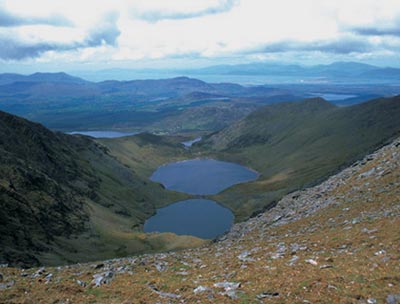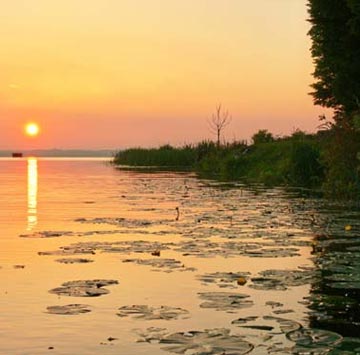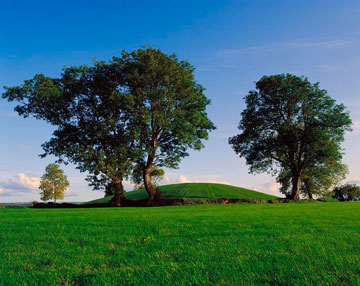Ireland
Country statistics

Land area: 26,598 sq miles (68,889 sq km)
Total area: 27,135 sq miles (70,280 sq km)
Population (2010 est.): 4,250,163 (growth rate: 1.1%); birth rate: 14.2/1000; infant mortality rate: 5.0/1000; life expectancy: 78.4; density per sq km: 60
Capital City: Dublin
Monetary unit: Euro (formerly Irish pound [punt])
Languages: English, Irish (Gaelic)
Ethnicity/race: Celtic, English
Religions: Roman Catholic 91.6%, Anglican 2.5%, other 5.9%
Country introduction

The island of Ireland is located in North-west Europe in the North Atlantic Ocean, west of Great Britain. Ireland is separated from Britain by the Irish Sea and from mainland Europe by the Celtic Sea.
The island is comprised of a large central lowland made up of limestone and hills surrounded by a border of mountains around the coast of varying structure. A ring of coastal mountains surrounds low central plains. The central plain is extremely fertile and the climate is warmed by south-westerly winds making it temperate and moist. The total length of the island's coastline is 3,172 km (1,970 miles).
The highlands of the north, west, and south are generally barren and rise more than 3,000 ft (914 m). The highest peak is Carrauntuohill (Irish: Corrán Tuathail) in the south, which is 1041 m (3415 ft).
The island is bisected by the River Shannon, at 386 km (240 miles), making it the longest river in either Britain or Ireland. It flows south from North-west County Cavan to meet the Atlantic just south of Limerick. It also contains large areas of bogland, used for peat production.
There are a number of sizeable lakes along Ireland's rivers, of which Lough Neagh is the largest.
Rain is common throughout the year, helping to contribute to the country's lush vegetation and green countrysides, which as result has earned it the nickname of 'Emerald Isle'.
The island's lush vegetation and green countrysides has earned it the nickname of 'Emerald Isle'.
The culture

Ireland is well known for its many myths and legends which began long ago when the Celts ruled Ireland and many tales were told by the Druids. There are many fun and wonderful stories of fairies and leprechauns. It is said that fairies dwell in mounds in the earth and to touch one of these mounds is to bring bad luck. Leprechauns, on the other hand, bring good luck, especially if one is caught. It is said that leprechauns are mischievous, but will lead a person to their pot of gold, which they keep at the end of the rainbow. However, they will disappear if sight of them is lost for even just a moment. There are also many other tales of skilled warriors, the eerie wail of the Banshee, brave queens and gods, lovers and a horse spirit who can take the form of a handsome man, and many more. The Irish are wonderful story-tellers and there are many books available on Irish myths and legends.
Ireland is known to be a nation of scholars and there are many well known authors, playwrights and poets from the Emerald Isle. Frank McCourt, Jonathan Swift, Oliver Goldsmith, Oscar Wilde, Samuel Beckett, George Bernard Shaw and Seamus Heaney are just a few of the greats. Ireland is now known around the world for inspiring the works of it's natives, such as James Joyce and William Butler Yeats, in the more recent centuries. These famous writers have captured the culture of Ireland, from rural island life to the struggles of life in urban Dublin. A strong sense of pride and appreciation is felt over the country regarding their history of literary works.
Music is almost as old as Irish mythology is in the culture. The country's unique music has evolved over time to what is commonly known as Irish music these days. Instruments such as fiddles, harps, flutes, banjos, bodhráns (hand-held drum) and violins are used to create the traditional Irish melodies. Lyrics have been added over the years to such melodies which reflect the culture of the times. Many of these traditional Irish songs are about mass immigration, civil conflict and everyday life. Irish dancing is a popular companion to this music, which is still taught and performed by the Irish.
The Irish word "céili" is used to describe an informal evening of traditional Irish music and dancing. Irish step-dancing is performed mostly with the legs and feet while the arms hang stiffly at the side. The traditional Irish dress for Irish female dancers are copies of the traditional Irish peasant dress and feature elaborate Gaelic designs. The shoes are similar to ballet shoes which are laced over the feet and the ankles. The male's costume is less elaborate, with them wearing plain kilts or pants and jackets, and folded cloaks that hang from the shoulders, called brats. RiverDance and Lord of the Dance have brought international acclaim to Irish music and dance. RiverDance is an exciting performance of music, dancing and singing. The performance depicts the evolution of Irish culture and its influence on other cultures through immigration during the potato famine. The Lord of the Dance is an outstanding dance performance and a celebration of the Celtic heritage.
Drinking is an important part of the Irish culture. Locals come into enjoy a pint, "crac" (humorous conversation), and gossip with their neighbors. All members of the community are allowed into pubs, it is common to see families eating there at meal times. Traditional Irish music and dancing are regular at pubs along with the storytelling of legends. Alcohol production and exportation is one of the oldest industries and has helped Ireland in their economic growth.
Ireland's national holiday is St. Patrick's Day, celebrated on March 17. St. Patrick is Ireland's saint and his feast day has become a special occasion, not only for Irish people but for many other people as well, for thousands of people In Ireland, the day begins with church services. Later in the day, parades are held all over. The principal parade takes place in Dublin. Easter Sunday is celebrated with church services, followed by festive family meals. Children boil and decorate eggs and have contests to see who can eat the most eggs.
Attractions & landmarks

Navan Fort is the most important archaeological and historical site in Northern Ireland. The hilltop enclosure and ritual site is also known by its ancient Irish name, Emain Macha. It was constructed around 95 BC, and it is recorded in the Ulster Cycle and other Irish legends as once being a major centre of power in what today is County Armagh, the capital of the Ulaidh. There is free access to the fort but to appreciate the site's history it is best to go into the navan centre. Another attraction in Armagh City include the Planetarium, which was set up to educate and entertain visitors with insights into the mysteries of space. Armagh City is also full of quaint little georgain streets.
The southern shores of Lough Neagh and the nearby Craigavon lakes, are popular for watersports, fishing and bird watching. Lough Neagh in particular is the largest lake in Ireland and Britain with an area of 392 sq km (151 sq miles). It supplies 40% of its water used in Northern Ireland.
The Cliffs of Moher are another top Irish landmark destination. Travelers brave the cold and fog all for the sake of seeing the famous cliffs overlooking the wild Atlantic Ocean. The cliffs are located in County Clare and rise more than 214 m (700 ft) at their highest point.
The capital, Dublin has many landmarks and monuments dating back hundreds of years. One of the oldest is Dublin Castle, which was first founded as a major defensive work on the orders of King John of England in the United Kingdom in 1204. Dublin's St. Patrick's Cathedral is another historic Irish institution. This famous church was founded in 1191 and sees more than 300,000 visitors a year. Other popular landmarks and monuments include the Spire of Dublin, the Mansion House, the Anna Livia monument, the Molly Malone statue, Christ Church Cathedral, St Patrick's Cathedral, Saint Francis Xavier Church on Upper Gardiner Street near Mountjoy Square, The Custom House, and Áras an Uachtaráin. The Poolbeg Towers are also iconic features of Dublin and are visible in many spots around the city.